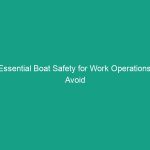Good Morning Team!
Today, we’re diving into an important topic: Equipment Lockout/Tagout Tags. Understanding and properly using these tags is essential for maintaining Safety in our workplace. Lockout/Tagout (LOTO) practices are crucial in preventing accidental equipment start-up during Maintenance and servicing, which can lead to serious injuries or fatalities. Let’s explore why this topic matters and how each of us plays a role in ensuring a safe working Environment.
Understanding Equipment Lockout/Tagout Tags
Lockout/Tagout tags are critical Safety tools used to inform employees that a specific piece of equipment has been locked out and is not to be operated until it is safe to do so. These tags serve two main purposes:
- To warn employees not to operate the equipment.
- To ensure that maintenance or repair work can be completed safely.
It’s important to recognize that failure to adhere to these Procedures can result in serious accidents. Many employees may believe that they can bypass these protocols without risks, but this misconception can lead to severe consequences.
Key Hazards, Risks, and Safety Considerations
When it comes to LOTO procedures, several key Hazards and risks need to be acknowledged:
- Unexpected Equipment Start-Up: One of the most significant hazards is the unintentional start-up of machinery while someone is performing maintenance. This can lead to severe injuries or even fatalities.
- Failure to Isolate Energy Sources: If energy sources (like electricity, hydraulic, or pneumatic energy) are not properly isolated, there is a risk of equipment malfunction.
- Inadequate Communication: If team members are not aware of lockout/tagout procedures in place, they may inadvertently start equipment that is under maintenance.
The consequences of ignoring these risks can be dire, including serious injuries, equipment damage, and financial losses for the company. Therefore, adhering to lockout/tagout protocols is not just a regulatory requirement; it’s a moral obligation to ensure everyone’s safety.
Best Practices, Procedures, & Actionable Advice
Now that we understand the importance of LOTO tags, let’s go over some Best Practices that you can follow to ensure safety:
Step-by-Step Lockout/Tagout Procedures
- Prepare for Shutdown: Review the equipment and understand its energy sources. Ensure you have the correct lockout/tagout devices.
- Notify Affected Employees: Inform all employees who may be affected by the shutdown that maintenance will occur.
- Shut Down Equipment: Use the proper procedures to shut down the equipment safely.
- Isolate Energy Sources: Disconnect all energy sources (electricity, gas, hydraulic, etc.) and ensure they cannot be re-engaged.
- Apply Lockout/Tagout Devices: Use a lock and a tag on each energy-isolating device to indicate that the equipment is out of service.
- Verify Isolation: Before performing maintenance, double-check that the equipment is properly isolated and cannot be started.
- Perform Maintenance: Carry out the necessary work safely.
- Remove Lockout/Tagout Devices: Once maintenance is complete, ensure that all tools and personnel are clear before removing locks and tags and returning the equipment to service.
Using real-life examples, consider a scenario where a worker did not follow LOTO procedures and was injured when a machine unexpectedly started. This incident serves as a stark reminder of the importance of following these protocols.
Regulations, Standards, and Compliance
Compliance with safety Standards is non-negotiable. The Occupational Safety and Health Administration (OSHA) has established Regulations for lockout/tagout procedures in 29 CFR 1910.147. Here are some key points regarding compliance:
- Employers must establish an energy control program.
- Employees must be trained in LOTO procedures and the importance of compliance.
- Regular audits and inspections should be conducted to ensure adherence to LOTO policies.
Understanding and complying with these regulations not only protects employees but also shields the company from legal repercussions and financial liabilities.
Employee Engagement & Discussion
Now that we’ve covered the essential aspects of equipment lockout/tagout tags, let’s engage in a discussion. Here are a few questions to consider:
- What safety challenges have you encountered related to lockout/tagout tags?
- Can anyone share an experience where LOTO procedures were correctly followed or perhaps overlooked?
- How can we improve our current LOTO practices to prevent accidents?
Your insights are invaluable, and discussing these topics can lead to enhanced safety practices and a more proactive safety culture in our workplace.
Conclusion & Key Takeaways
In conclusion, understanding and properly using lockout/tagout tags is a vital aspect of Workplace Safety. Remember these key points:
- Always follow lockout/tagout procedures to prevent accidental equipment start-up.
- Ensure all employees are informed and trained on LOTO practices.
- Regularly review and update safety procedures to comply with regulations.
By prioritizing these practices, we can create a safer work environment for everyone. Thank you all for your attention today, and let’s continue to commit to safety in our workplace!


